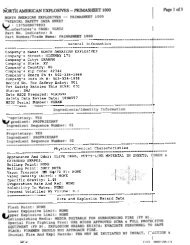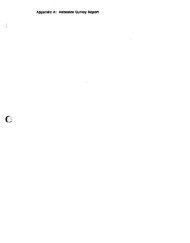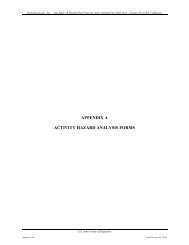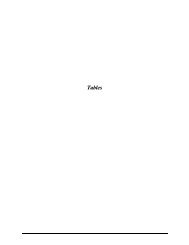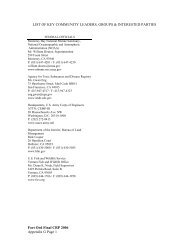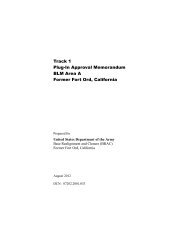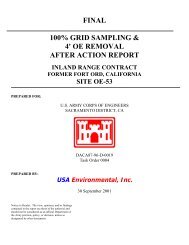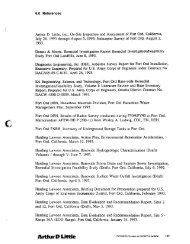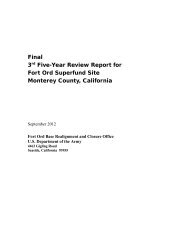Final Second Five-Year Review Report Fort Ord Superfund Site ...
Final Second Five-Year Review Report Fort Ord Superfund Site ...
Final Second Five-Year Review Report Fort Ord Superfund Site ...
Create successful ePaper yourself
Turn your PDF publications into a flip-book with our unique Google optimized e-Paper software.
With regard to the area within the boundary of the Former <strong>Fort</strong> <strong>Ord</strong>, the groundwater remedy, comprised<br />
of the source area GWETS and the HCPP system, is continuing to effectively reduce the total mass and<br />
concentration of COCs in groundwater. Groundwater samples from all A-Aquifer MWs within the<br />
capture zone of the source area GWETS met the clean-up targets in the December 2005 event. Operation<br />
of the source area GWETS was suspended in February 2006 to conduct a rebound evaluation study and<br />
determine if the system can be permanently shut down.<br />
At the northwestern property boundary, the initiation of pumping from the HCPP during July 2006 is<br />
intended to halt the migration of the VOC plume beyond the property boundary. Although the HCPP has<br />
not been operating or monitored long enough to reach definitive conclusions regarding performance, the<br />
initial data suggest that the desired hydraulic control of the plume has been established along the<br />
northwest property boundary.<br />
With regard to the area downgradient from the northwest property boundary of the Former <strong>Fort</strong> <strong>Ord</strong>, MW<br />
data from early 2007 show that concentrations of TCE exceeding the aquifer cleanup level extend<br />
approximately 400 feet beyond the boundary of the former <strong>Fort</strong> <strong>Ord</strong>. This part of the plume is not being<br />
captured by the HCPP system, although the HCPP system will prevent further migration beyond the<br />
property line. The Army is characterizing the extent of the contamination and evaluating options for<br />
addressing the plume beyond the property line.<br />
Monterey County <strong>Ord</strong>inance 4011 has been put into effect that regulates water well installation within<br />
either the “Groundwater Prohibition Zone” or “Groundwater Consultation Zone,” which includes the<br />
known groundwater plumes at the former <strong>Fort</strong> <strong>Ord</strong>. In addition, the Army has included groundwater use<br />
restriction in the federal deed and has executed a Covenant To Restrict Use Of Property (CRUP)<br />
(recorded with the deed) for all transferring parcels that are located over the groundwater plume. The<br />
deed restriction and the CRUP will prohibit construction of wells for injection or extraction of any<br />
groundwater until the aquifer cleanup levels are attained.<br />
5.3.2 Question B<br />
Are the exposure assumptions, toxicity data, cleanup levels and RAOs used at the time of the remedy<br />
selection still valid?<br />
Land use within the limits of the groundwater plume is consistent with the exposure assumptions used for<br />
the development of the aquifer cleanup levels specified in the OU 1 ROD. The standards for site aquifer<br />
cleanup levels were based on state and federal maximum contaminant level (MCL) except where more<br />
stringent values were developed from the human health risk assessment. The MCLs for the OU 1 COCs<br />
have not changed since the OU 1 ROD was signed, thus the aquifer cleanup levels are still in compliance<br />
with, or more conservative than, federal standards. Maximum COC concentrations detected in the OU 1<br />
groundwater monitoring network since the OU 1 ROD was signed are less than the maximums identified<br />
in the OU 1 ROD.<br />
5.3.3 Question C<br />
Has any information come to light that could call into question the protectiveness of the remedy?<br />
As described in above, MW data from early 2007 show that concentrations of TCE exceeding the aquifer<br />
cleanup level extend approximately 400 ft beyond the boundary of the former <strong>Fort</strong> <strong>Ord</strong>. The existing<br />
extraction system is not able to capture this part of the plume and the Army is evaluating options to<br />
address this portion of the plume. The HCPP system will prevent further migration beyond the property<br />
line.<br />
<strong>Final</strong><br />
5-4<br />
FORMER FT ORD 5YR REVIEW 2007_FINAL United States Department of the Army



